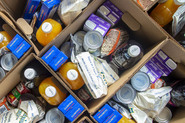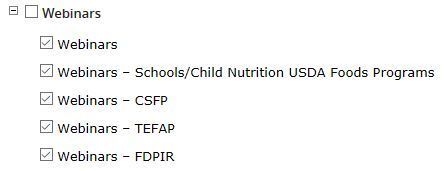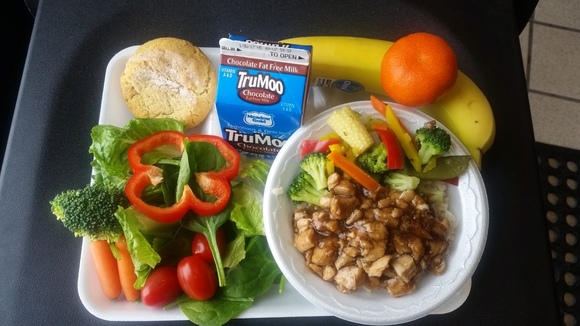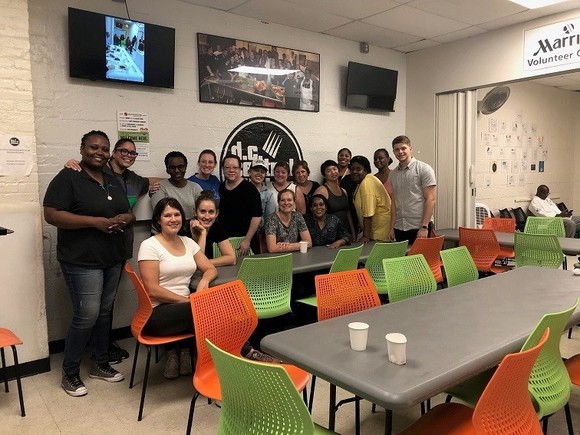USDA Foods Trade Mitigation Food Purchase and Distribution Program
USDA is going to be purchasing a lot more food than usual over the next year. Why is that and what does it mean for your program? In order to support American agriculture impacted by recent tariffs, the agency has planned to purchase up to $1.2 billion of additional foods through the USDA Foods program. In August 2018, USDA identified a list of food categories and target purchase amounts. Items are being purchased in four phases which roughly correspond to calendar quarters, and most purchases for phase 1 (late December 2018 to March 2019 deliveries) have been completed. The majority of these items will support Food Banks and other emergency feeding organizations that receive food through The Emergency Food Assistance Program (TEFAP). However, some trade mitigation products will also be made available to programs receiving USDA Foods through the National School Lunch Program (NSLP), Child and Adult Care Food Program (CACFP), Commodity Supplemental Food Program (CSFP), and Food Distribution Program on Indian Reservations (FDPIR). More information will be sent to State agencies and Indian Tribal Organizations as products are selected and catalogs are opened for ordering these foods. Program sites will receive additional information about ordering opportunities through their State agencies in 2019.
Turkey isn’t the only star this holiday season; pork also has a place at the table! In addition to regular purchases of pork products through the USDA Foods program, USDA is supporting American pork producers impacted by recent tariffs. Pork, one of many items to be purchased during the trade mitigation efforts, is the featured food this month.
Pork is a versatile meat that can be served at any meal and if eaten in moderation, can be part of a healthy diet. From pork patties for breakfast to a pork loin roast for dinner, there is always room for pork. Its overall nutritional content stacks up very similarly to beef and lamb, and it is an excellent source of protein, iron, B vitamins, selenium, and zinc.
Need some ideas or new recipes? Check out the Team Nutrition pork recipes for child nutrition programs, the What's Cooking? USDA Mixing Bowl pork recipes for households, and these easy how-to videos featuring everything you need to know about cooking and preparing pork.
New Program Photos Available through USDA Flickr
Did you know that USDA has a Flickr site filled with images of USDA programs, clients, and food that you can use? USDA photographers are in the field continuously capturing the great work of programs around the agency, including Food and Nutrition Service (FNS) programs. We recently added new albums from visits to CSFP, TEFAP, and FDPIR program sites that highlight some of the great food assistance work happening around the country, but there are also lots of photos of school meals, farmers markets, and other food images. Check out the full USDA Flickr here!
Food Distribution Program at Seminole Nation of Oklahoma, Nov. 6, 2018
Webinars Past & Future
In Case You Missed It: Webinar Archives
Food Distribution hosts webinars and trainings for distributing agencies and recipient agencies on the fundamentals and best practices for USDA Foods in child nutrition and household programs. Visit the Food Distribution playlist on YouTube to watch the webinar recordings of any events you missed!
Our newest additions to the playlist are the recordings of our two recent webinars for the CSFP community, held on November 29 and December 12.
 How to Encourage Variety in the CSFP Food Package: How does your program decide what to put in the CSFP food boxes each month? How can planning and creating menus help ensure you provide seniors with a variety of items to meet their food needs? Listen in to hear from USDA and CSFP program representatives about best practices to ensure that your program can serve a variety of foods in the CSFP food boxes.
CSFP Caseload Management Tips: This webinar highlighted best practices and lessons learned on CSFP caseload management. Guest speakers from CSFP State and local agencies shared successful strategies they have used to manage caseload and expand their programs.
2019 Webinars
We are putting together our 2019 webinar calendar and are excited to offer a number of training events in the new year! Stay tuned for more details and review your GovDelivery subscription preferences to ensure you are signed up to receive registration information about future events for the programs that interest you.
|
 |
Show Us Your Tray Photo Contest Reminder
The 2019 Show Us Your Tray Photo Contest for USDA Foods in Schools is in full swing! Within minutes of announcing the photo contest during National School Lunch Week, we started receiving amazing photos from schools across the nation, highlighting how they use their USDA Foods. Don’t be left out in the cold! Send us a picture of your most creative dish. It could be a main entrée, a side dish, or even a tasty dessert. With more than 200 USDA Foods items available, we want to feature each food group and the innovative ways in which they can be used. Check out the Show Us Your Tray website to read the contest rules. Submit your photos to USDAFoods@fns.usda.gov by January 15, 2019!
 |
Disclaimer: By submitting photos to this contest, you consent that they may be used by the U.S. Department of Agriculture, and/or others with the consent of USDA, for the purposes of illustration or publication in any legally authorized manner. You understand that these pictures and information will be used in educational materials, such as USDA brochures, newsletters, videos, or news releases, to help others understand how USDA programs help people. The pictures and information will not be used for any commercial, money-making purpose.
New Nutrition Facts Panels for Food Products
You may notice that the Nutrition Facts Panel on some food packages has started to look a little different. That is because the U.S. Food and Drug Administration (FDA) updated the requirements for the Nutrition Facts Panel to help consumers make better informed food choices. Some changes include:
- larger font size for calories and serving size
- separate listing for “added sugars” to show the difference between naturally occurring sugars, such as those found in fruit and milk, from the sweeteners that are added as an ingredient
- different nutrients being reported as Vitamin A and C are no longer required, but Vitamin D and Potassium take their place on the label
USDA Foods products are also beginning to see updated Nutrition Facts Panels as a result of the changes, but companies have until 2020 or 2021 to complete the changes, so you may see these changes incorporated over time. If you have any questions about USDA Foods product labels, please email USDAFoods@fns.usda.gov.
New USDA Foods Information Sheets
USDA Foods Product Information Sheets help schools learn more about the nutritional content and crediting yields of the USDA Foods they serve. We’ve recently added Product Information Sheets for the following new items:
|
100119 – Turkey Taco Filling, Cooked, Frozen
110554 – Turkey, Deli Breast, Sliced
110911 – Turkey, Smoked Ham, Sliced
110711 – Beef, Patties, Cooked, Frozen
110730 – Pork, Pulled, Cooked, Frozen
110921 – Chicken Fillet, Cooked, Unbreaded, Frozen
110931 – Egg Patty
|
|
 |
We look forward to hearing your feedback about these products or other items you would like to see at USDAFoods@fns.usda.gov.
Volunteering at DC Central Kitchen
On October 11, USDA staff members had the opportunity to volunteer at DC Central Kitchen (DCCK) in Washington, DC, as part of the Feds Feed Families Campaign. Feds Feed Families was created to help food banks and pantries stay stocked during summer months when they traditionally see a decrease in donations and an increase in need. During the visit, the group transformed otherwise wasted food into balanced meals for the community. These meals are then put onto a fleet of trucks and delivered to more than 80 partner agencies in the Washington metropolitan area, including homeless shelters, rehabilitation clinics, and after-school programs. Staff members worked with DCCK kitchen staff to cut, chop, peel, and prep food. Visits like this are always a great opportunity for USDA staff to see firsthand the innovative work of local organizations. We thank DC Central Kitchen for the opportunity to have an inside peek at how they contribute to breaking the cycle of hunger and poverty.
 |
USDA staff volunteer at DC Central Kitchen.
WBSCM Changes to Support Trade Mitigation
The Web-Based Supply Chain Management system (WBSCM) has been updated to support ordering USDA Foods through the Trade Mitigation program. Reports related to the status of these orders as well as tracking associated spending on Trade Mitigation materials have been enhanced for the latest WBSCM release on December 14, 2018, including:
- Each food distribution program has an associated program and catalog for Trade Mitigation ordering, which is identified by “TM_” and the first two letters of the respective program. FNS will assign catalog(s) to State Distributing Agencies when ordering opportunities are available.
- These Trade Mitigation programs are available as selection criteria for associated reports such as the Requisition Status Report, the Order Status Report, and all types of Entitlement Reports.
- On the Entitlement/Bonus Summary Report, the new “Trade Pounds” and “Trade Order Total” reflect the weight and value of materials ordered through the Trade Mitigation program. Note: Items ordered through the Trade Mitigation program do not impact entitlement.
- On the Entitlement / Bonus Detail Report, the “Ent. / Bonus (E/B)” column will display “E” for Entitlement, “B” for Bonus, or “T” for Trade Mitigation.
A summary of all changes introduced to WBSCM, including the impacted user groups and links to related training materials, is provided in the monthly Release Notes. To access the WBSCM document library, navigate to Help -> Training -> and then drill down through the different types of training materials.
For additional assistance, contact the WBSCM Service Desk or call (877) 927-2648.
As 2018 ends, the USDA Foods Complaint Team continues to work to provide timely and responsive customer service, investigate and resolve complaints, and provide guidance on how to properly and safely handle USDA Foods. To us customer feedback is an opportunity to make improvements to USDA Foods. We work closely with our partners at the Agricultural Marketing Service (AMS) to improve product specifications to ensure consistent, high quality USDA Foods that meet customer expectations.
We need your continued assistance to ensure USDA Foods meet your expectations. It is the responsibility of the State Distributing Agencies (SDAs), Indian Tribal Organizations (ITOs), and Recipient Agencies (RAs) to ensure that each delivery of USDA Foods is inspected prior to being unloaded and as it is being unloaded to determine the overall condition of the USDA Foods, verify the quantity of product, and note any issues. This includes USDA Foods received at each delivery location in a split shipment. Staff should be trained on how to properly receive and store USDA Foods. At the time of delivery and before the truck leaves, we recommend that you inspect the following:
- Confirm that the security seal is intact and that the seal number matches the number on the bill of lading (BOL).
- Verify that temperatures for refrigerated and frozen products are appropriate to ensure that the foods were properly maintained during transport.
-
Confirm that the quantity of the product received matches the quantity on the BOL. A more careful count must be conducted as the shipment is unloaded and prior to the vendor departing. Indicate any shortages or overages in the shipment on the BOL.
- Examine the quality and condition of the product; inspect for damage.
- Check the condition of the packaging and containers. Take time to walk around pallets, open a few cases, and, if needed, open internal packaging to check product.
- Document any issues on the BOL, prior to signature, and take photos.
Remember to take action immediately if USDA Foods do not meet specifications. Vendors have a contractual obligation to deliver USDA Foods in a safe and acceptable manner. RAs who have issues or concerns with USDA Foods product(s) should contact their SDA and provide as much information as possible. The SDA will report the complaint through the Web-Based Supply Chain Management System (WBSCM).
Instructions for receiving shipments of USDA Foods: USDA FNS Instruction 709-5, Rev 2, Shipment and Receipt of USDA Foods and USDA FNS Policy Memorandum FD-107, Storage and Inventory Management of USDA Donated Foods
Instructions for filing a USDA Foods Complaint: How to File a Complaint
The Complaint Team is available Monday-Friday, 6:00 a.m. – 5:00 p.m. Eastern Time. Email USDAFoodsComplaints@fns.usda.gov or call the USDA Foods Complaint Hotline at 800-446-6991.
USDA staff will be participating in these upcoming meetings in 2019. We look forward to the opportunity to meet you and hope to see you there!
February 24-26: School Nutrition Association (SNA) Legislative Action Conference in Washington, DC.
February 24-26: National Anti-Hunger Policy Conference, co-hosted by Feeding America and the Food Research & Action Center in cooperation with the National CACFP Forum, in Washington, DC.
May 5-8: American Commodity Distribution Association (ACDA) Annual National Conference in Niagara Falls, New York.
June 10-12: National Commodity Supplemental Food Program Association (NCSFPA) Annual Conference in Alexandria, Virginia.
June 10-13: National Association of Food Distribution Programs on Indian Reservations (NAFDPIR) Annual Conference in Philadelphia, Mississippi.
 1. Click here. Or you can go to the Food Distribution website and click on the red envelope on the row of social media icons on the top right of the page.
2. Enter your email address and click "Submit."
3.
Check the boxes to select your topic(s) of interest. For these
e-letters, scroll down to the Food Distribution category and click the
plus sign to the left of the check box to expand the list and view all
the topics. Select any of these topics to receive the general e-letter
plus the corresponding program-specific e-letter(s) of your choice:
*USDA Foods --> receive all "USDA Foods from Farm to Plate" e-letters
*Commodity Supplemental Food Program (CSFP) --> receive "Household Highlights"
*The Emergency Food Assistance Program (TEFAP) --> receive "Household Highlights"
*Food Distribution Program on Indian Reservations (FDPIR) --> receive "FDPIR Connection"
*Schools/Child Nutrition Commodity Programs --> receive "Spotlight on Schools"
4. Visit the subscriber preferences page any time you would like to review, add, or delete subscriptions. Questions? Contact USDAFoods@fns.usda.gov.
5. Share the e-letter and new subscriber link with interested colleagues and friends!
|
|